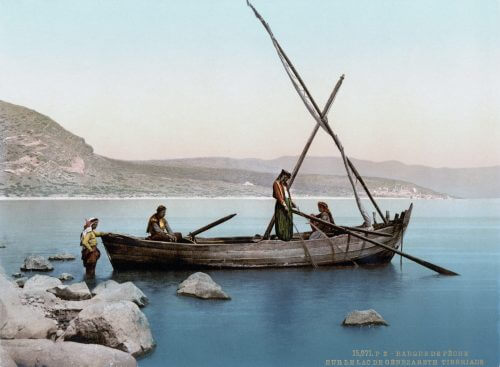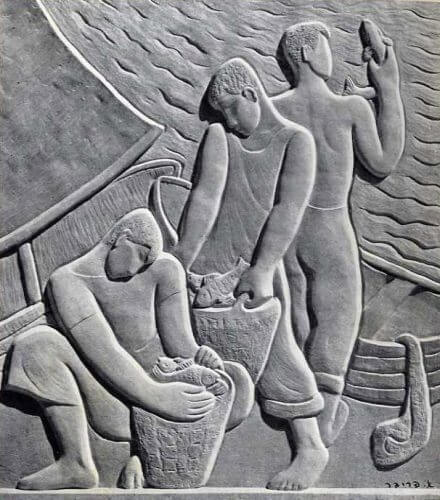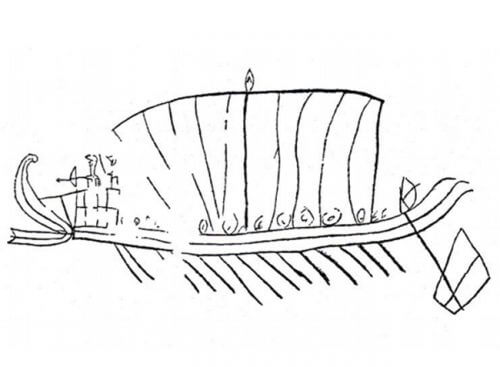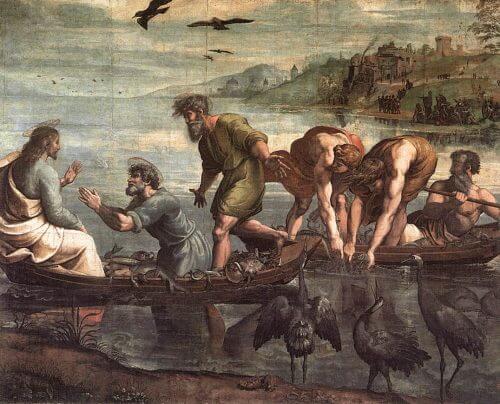First part of a mini-series about fishing in ancient Israel

Chapter XNUMX - A Greek word in the Bible? is that so?
The nation of Israel with its tribes and divisions was far away from the world of fishing in its early days. It is true that according to Jacob's blessing to the tribes we find the tribes of Asher, Manasseh, Dan and Zebulun bordering the sea, with the possible exception of the tribe of Zebulun whose proximity to the sea was quite loose, and in the book of Judges under the title of Deborah's poem we read that "And Dan, why should ships dwell there. "Whoever sits on the shore of the sea and in its gulfs will dwell" (Judges 17:XNUMX), however, the people of Israel mostly dealt with it as a whole, some in grazing and some in agriculture, and was distant from the world of fishing a decent distance.
Although the Bible is not structured in parts in a chronological format. We can very carefully determine some stages of development and progress in the subject of our discussion. Thus, for example, in the book of Genesis, in the very first chapter, God announces as follows: "Let us make man in our image, after our likeness, and let them come down with the fish of the sea and the fowl of the sky..." (Genesis 26:XNUMX). And by the way, it is interesting, as I have already mentioned in many other places, that God appears in the plural pronoun (God) and even his teaching/their teaching in the plural - "in our image", "in our image".
The classic sentence of "the exodus from Egypt" and the "journey in the desert" along the lines of "We remembered the fish that we ate in Egypt for free..." (Bamadbar 5:XNUMX) makes it difficult for us to draw any conclusion about fishing, especially on the basis of the last word, although fishing in the Nile region was really common Like the field crops in the Judean region.
An interesting episode, which brings up the exploits of Samson in Gaza, in the destruction of the temple of the god Dagon. Dagon was the god of grain and agriculture whose worship was already known from the middle of the third millennium BC and was the main god of the Philistines, whose origin probably coincides with the origin of the Philistines, that is, in the Aegean, Greek culture. His name may be related in one way or another to fishing and fishing culture, and he is depicted, although in much later generations as half fish and half man.
According to the book of Joshua, there was a "House of Dagon" in the territory of the Asher tribe. The temple of the god Dagon in the city of Ashdod is mentioned in the book of Samuel 54 in the story of the capture of the Ark of the Covenant by the Philistines. And among the relief stone, from the description of Dagon's fall before the Ark of God, it can be learned that according to the author's view, a human-like statue stood in the Ashdod temple (so according to the research of Itamar Singer, to the problem of the identity of Dagon, the God of the Philistines, Kathedra, 1989, December 18, p. XNUMX ).
Whether and to what extent the pre-Yahwistic and Hewistic worship was influenced by the Philistine culture in relation to fishing is unknown and it is not known whether any conclusion can be drawn regarding fishing among the people of Israel.
The control of the sea and the launching of merchant ships at the initiative of King Solomon in the direction of Africa, the Red Sea, the Sea of Eilot and Tarshish, either with the assistance of Hiram the King of Tire or on his own initiative, brings us closer to the world of fishing, although only at the level of a loose hypothesis.

In a later period, say from the eighth century BC onwards, the evidence of fishing in Israel increases, relatively of course. We learn this from the mention of the following phrases: fishermen, boycotters, fishing, oar catchers, rod throwers, trawlers, citadel, davgs (fishing boats), tzins (fishing boats with a pointed prow), net retirement, tzelz and more.
The interesting thing is, as I have argued on many occasions: when some expression slips from the physical context to the allegorical one, this shows its immersion in the ethnological culture. Such as: "His skin was filled with scabs and the sound of fish in his head" (Job 31:12), or "For man did not know his time like fish that cling to an evil citadel..." (Kohelat XNUMX:XNUMX) and more.
Is it a natural development alongside agriculture and crafts? Is it a growing influence of neighboring cultures? Is this a phenomenon of the development of maritime trade from the time of Solomon onwards? It is impossible to know, but it is difficult to argue with linguistic facts.
We mentioned the Dagon cult earlier and we will link it with the strengthening of the ties between Israel and the Philistines and their maritime culture, especially from the days of David onwards and here and there certain mentions of ties with the Greek culture which was mostly concerned with the craft of fishing. And here is hidden in the Bible an unknown box that, in my humble opinion, closes the circle of context with Greek culture. Let's read and learn: "And let every living soul that ran into all that came to the river live, and there was a great abundance of fish, because these waters came to its name and were healed, and everything that came to the river's name lived. And there will be fishers standing on it, from the eye of a goat to the eye of a calf, from a flat to the forefathers, they will be of a kind, and their fish will be like the fish of the great sea, very much" (Ezekiel Psalm 10-9).
I am referring to the word "lamina" which I think originates from the Greek word "lyman" which means port, and this is the word that was taken up in the ancient Hebrew language by reversing the letters (lyman-port). And if so, we have before us a kind of interesting link that connects the Israelites and the Aegean-Philistine culture in relation to the sea, to fishing.
And what can we say about the phrase "the Fish Gate" which was built in Jerusalem and is first mentioned in the project of King Manasseh - "And after that he (Manasseh) built an outer wall for the City of David, west of Gihon by the river and come to the Fish Gate..." (14 Chronicles 3:XNUMX) and he is the one who is mentioned in the construction project / The restoration of the walls of Jerusalem by Nehemiah - "And the Fish Gate was built by the sons of Sanaa. They shall build it and set up its doors, its locks and bolts" (Nehemiah XNUMX:XNUMX), when, Nehemiah, he divides the building of the wall and its restoration into sections, under the responsibility of each patriarch's house.
What did the "fish gate" symbolize? Was there a fish market or canned fish near it (more on that later)? And perhaps fish were stamped on the gate, lest in the form of the pair of fish swimming in opposite directions as in the mosaics of the zodiac in late Jewish synagogues (Beit Alpha, Susia, Hamat Tiberias, etc.)
In the book of Habakkuk, which is of course later, a very interesting picture involving fishing unfolds as follows: "And you will make a man like the fish of the sea, like an unruly fish. All with a raised rod, they will gather him in his sack and gather him in his cellar. That's why Vigil will be happy. Therefore, he will sacrifice to his fornication and complain to his servant, because an animal fat its part and its food is raw. The Lord will spit out a boycott and will always kill Gentiles with no mercy" (Habakkuk 17:14-XNUMX). On the one hand, the image strengthens the connection between the people of Israel and the occupation of fishing, and on the other hand, it explains to us the processes of the fisherman's craft and his craft.
In the Jewish literature of the Second Temple, that is, the external literature, expressions taken from the life of fishing appear, but from which it is difficult to extract broad and comprehensive information about the life of fishing in Judea. We will understand this against the background of the Jewish settlement moving away from the coastline, except that the area of the Sea of Galilee, or as we know it by its name, the Sea of Galilee. In the south of the Ganoser Valley, there was a Jewish settlement center that was mostly engaged in fishing. The meaning of Nunya tower is the fish tower (from Nun, Nunya - fish/fish in Aramaic). This center was first mentioned during the Second Temple period in the struggle between the supporters of Yohanan Hyrcanus II and Antipater the Edomite and the supporters of Judah Aristobulus II, both Hasmoneans in 54 BC.
This place is called Tarikai in Greek and means "the place of salting the fish" (and to you "fish preserves" at that time).
The relative abundance of the Jewish population in this period near the Sea of Galilee, as well as the Jewish approach towards the coastline, and in particular the conquest of Jaffa by the Hasmonean Jonathan and its settlement with Jews, as well as the upgrading of the Jaffa port, ultimately led to a strengthening of the connection between the Jews and the fishing profession. Also, the conquest of Gaza by Alexander Yanai and its destruction strengthened the importance and the totality of the operations of the Hippo port for its ships and fishermen. And perhaps we can confirm this on the numismatic basis of many coins that were issued during the time of Alexander Yanai the Hasmonean (76-103 BC) on which paintings of anchors are sometimes surrounded by a ribbon and sometimes by a circle. During this period Jason's tomb was discovered in Jerusalem with a painting of a merchant ship, with a figure named Jason on board.

During the time of King Herod (4-37 BC), which saw a significant economic boom in Judea, royal coins were uncovered with an anchor between two olive branches, as if to indicate the agricultural boom alongside the maritime one. This phenomenon also existed in the days of his son Archilaeus, who next to an anchor with arms were also stamped with drawings of a ship's prow and a ship with oars. In the days of his grandson, Agrippa I, symbols of an oar, a ship's rudder and a rowing ship were stamped.
In the days of his other son, Herod Antipas (4 BC - 39 AD), the city of Tiberias was built at the foot of the Sea of Galilee as a relatively large economic and social center (20 AD) and this reduced even slightly the naval activity of the Nunia tower (historical). At that time, the activity of 16 fishing ports in the Sea of Galilee was recorded.
However, at this chronological stage we lack literature that would shed light on the life of Jewish society at that time, with the exception of rather weak information in the external literature and certainly the writings of Josephus ben Mattheyahoo by their very nature rarely shed light on economic, social and human aspects in general. This will be done for us by the literature of the Sages, which we will deal with in the next chapter and in the meantime we will content ourselves with the New Testament, from which it appears to what extent, and especially near the Sea of Galilee, fishing was popular among the population. In the Gospel according to Matthew (22:18-22) it was told about Jesus who was walking around the Sea of Galilee (which is the Sea of Galilee) and noticed two brothers - Simon called Peter (who would be one of his chosen disciples) and his brother Andrew "casting a fort in the sea" (we were fishing in the Sea of Galilee) , "Because they are fishermen" and convinced them to go with him along the lines of "Follow me and I will accuse you of being fishers of men." And they quickly left the trawlers and followed him." This is how Jesus used with two other fishermen, also brothers, to imply that their work is family, when they mend and fix their fishing nets, together with their father "and they will follow him" (the gospel according to Matthew 18:XNUMX-XNUMX). Apparently Jesus despised their work, but in fact sees them as a healthy foundation as his disciples, as a kind of complement to the above passage from the book of Habakkuk, and it is not for nothing that the fish became a revered and sacred element in Christian mythology.
And just to reinforce this, it was said that Jesus likened the kingdom of heaven to "a trawler that was thrown into the sea and various species will be gathered into it." And when it (the trawl) was full, they (the fishermen) brought it up to the seashore and sat down and gathered the good species into the vessels and threw away the bad ones" (The Gospel according to Matthew 48:47-XNUMX).
In the Gospel according to Luke (6:4-XNUMX) it was given as follows: "And it happened as his bride (Jesus) spoke to Simon: Move to the depths of the sea and lower your nets to hunt (fish). And Shimon answered and said to him: Master all night long, we have weeded and we have not caught (fished) anything. But according to you I will lower the trawl. And they did so and caught a great many fish, and their fishing line was torn."
Beyond the foundation of the miracle of the fish as a well-known myth in Christianity, the allegorical borrowing of Jesus in the previous passage and the statement in the current one shows how great was Jesus' positive, preferred attitude towards the fishermen over all other livelihoods, and not only because of his many activities in the Galilee.

The memory of the nunia-historical tower is embedded in the chronological bar of the Great Rebellion. After this center was captured by the Romans, the majority of the Jewish population fled towards the sea, the Sea of Galilee is the Sea of Galilee, and there was a great naval battle between Tarikai's Daigia-Spenia and the Roman army. According to the testimony of Yosef ben Matthew (The Wars of the Jews and the Romans 635 230), XNUMX fishing boats and ships were found in the Sea of Galilee, and in each one no less than four people, to teach about the strength of the fishing livelihood of the fishermen of Migdal Nunia and other fishing centers in the Sea of Galilee.
Finally, we would like to point out the fact that port cities were found along the coast from very ancient times, such as Dor-Dar from the middle of the fourth millennium BC, or Yavne-Yam, which was active from the Bronze Age and where an inscription from the Hasmonean period was discovered, when the Sidonians at that site implored the Seleucid king Antiochus V (son of Antiochus IV "Epiphanes") to give them concessions for the naval services they provided to his grandfather, Antiochus III. In Aramaic, the port city was called "Mukho Dimanin" (we were the port of Yavneh), to teach us, perhaps about the Jewish connection to this port.
The maritime urban center of Ashdod is called Ashdod-Yam, and Ashkelon was also known in Namla as well as Apollonia (Reshef-Arsuf), Migdal Stratton (which became the famous Caesarea on Namla in the days of Herod).
Jaffa, by the way, is considered one of the oldest port cities in the world, and it was called the "Jaffa Sea" port during the time of Ezra the Scribe (mid-fifth century BC). Judah the Maccabee destroyed it on an anthill, as an integral part of the fight against the Greeks and the Greeks (to teach us, by the way, about an ancient Jewish settlement in the place). His brother Jonathan, less jealous than him and close to the Hellenistic government, restored the city and the port and even made sure to send Jewish settlers to it.
And it turns out that Shlomo Artzi's song "Yidisha Piraten" was such a shock to some of the Jaffa Jewish travelers. These used to raid settlements and rob ships and in battles against the Romans during the days of the great rebellion, most of them fled and sought to find their salvation at sea. Unfortunately for them, a terrible sea storm broke out that sank their ships and 4200 of them drowned and their bodies were washed ashore.
So far we haven't properly gotten to know the Jewish fishermen. This task will be at the center of our discussion in the next chapter.

4 תגובות
Nice article
Yahyam Shalom
I would be happy to send you an article I wrote on the subject of fish farms and laundry facilities in Jerusalem during the Second Temple period, a renewed study of the archaeological findings.
If you are interested in the subject please send me an email address and I will send you the article.
The people of Israel returning to their land is a pretty good proof that we are in the right direction.
In short, an interesting article and thanks to Dr. Yechiam Sorek who succeeds in showing interesting aspects of the history of the people of Israel.